Application of Experimental Studies of Humidity and Temperature in the Time Domain to Determine the Physical Characteristics of a Perlite Concrete Partition
Abstract
:1. Introduction
2. Materials and Methods
2.1. Description of Research Methodology
- —heat flux;
- λ—thermal conductivity of the material;
- T—temperature;
- A—, where h—height of the wall, b—width of the wall.
- T1—air temperature on the inner surface of the material;
- T2—air temperature on the outer surface of the material;
- x2–x1—thickness of the layer.
- —heat flux;
- λ—thermal conductivity of the material;
- A—surface of the wall, , where h—height of the wall, b—width of the wall;
- T1—air temperature on the inner surface of the wall;
- T2—air temperature on the outer surface of the wall;
- x2 – x1—thickness of the layer;
- Tw1—air temperature on the inner surface of the wall;
- Tw2—air temperature on the outer surface of the wall;
- R1—thermal resistance of air on the inner surface of the wall;
- R2—thermal resistance of air on the outer surface of the wall;
- Rw—thermal resistance of the wall;
- α1—heat transfer coefficient for the inner side;
- α2—heat transfer coefficient for the outer side.
- λ(w)—thermal conductivity of wet material;
- λ0—thermal conductivity of dry material;
- Kw—coefficient of dependence of thermal conductivity on moisture;
- W—moisture content of the material.
- λ(w), λ0—as above;
- α—coefficient of influence of RH relative humidity on thermal conductivity (dimensionless);
- RH—relative humidity expressed as a fraction on a scale of 0 to 1 (e.g., 50% humidity is RH = 0.5).
- λ(w), λ0—as above;
- λw—thermal conductivity of water;
- λa—thermal conductivity of air;
- θw—the degree of filling the material with water, proportional to the moisture content (from 0 to 1).
2.2. Description of the Research
- Rh—relative humidity (%);
3. Results
3.1. Dependence of the Thermal Conductivity Coefficient on Air Humidity
3.2. Humidity and Temperature Tests at the Thickness of the Partition
3.3. Analysis of the Results
3.4. Statistical Analysis of the Results
4. Discussion
5. Conclusions
- -
- The value of the tested thermal conductivity coefficient depends on humidity. For the block in an air-dry state, it is 0.0956 W/mK, while for 50% humidity, it is 0.215 W/mK.
- -
- The temperature distribution in the sensors illustrated in the average daily temperature graphs shows that the temperature recorded by sensor no. 5 is approx. 20 °C higher than the temperature recorded by sensor no. 1, i.e., the one closest to the outer side of the partition. It can be noticed that sensor no. 1 responded most to temperature changes occurring outside the partition. The impact of these changes on the remaining sensors was smaller the further away they were from the outer side of the partition. Since temperatures recorded by five sensors at individual points of the partition were different, the values of relative humidity were also different, which found confirmation in measurements. The differences in relative humidity values between sensor no. 5 and sensor no. 1 exceeded even 50%. The thermal conductivity coefficient depends on relative humidity. Since relative humidity was different across the thickness of the partition in the locations of the sensors, the value of the thermal conductivity coefficient was also different. Therefore, it seems justified to assume that in such a case the average value of the thermal conductivity coefficient should be determined.
- -
- The graphs in Figure 7, Figure 8, Figure 9 and Figure 10 show that sensor no. 1 located closest to the outer side of the partition recorded higher relative humidity than air humidity outside the partition in some periods. This proves that perlite concrete blocks do not lose moisture quickly and their moisture persists for a long time. This leads to the conclusion that perlite concrete partitions require external protection against weather conditions. However, from the inner side, they are an excellent example of walls that have a positive effect on the internal microclimate.
- -
- The heat transfer coefficient for the partition 48 cm thick made of perlite concrete blocks in an air-dry state is U = 0.192 W/m2K (Table 3); that is, it corresponds to the maximum value of this coefficient for external walls 0.20 W/(m2K) allowed by the Regulation of the Minister of Infrastructure on the technical conditions to be met by buildings and their location. If perlite concrete blocks are not air-dry, the requirement resulting from regulation will not be met.
- -
- The relative humidity graphs drawn along the thickness of the partition indicate that the relative humidity inside the partition is higher than the relative humidity of the air of the inner side of the partition. This corresponds to the dependence of relative humidity on temperature.
- -
- In order to better understand the behaviour of moisture inside the partition and to assess the directions of its transfer through the tested material, the actual pressure was calculated. The results indicated a tendency to release moisture from the tested material, even in winter. This suggests that when perlite concrete is used in walls, their thermal insulation properties may improve as a result of drying.
- -
- During and under the experimental conditions, no conditions favouring condensation were observed inside the block, even in the most outer layer (2 cm). This allows for assuming that during typical use, i.e., in residential construction, perlite concrete will not get wet and, consequently, its thermal insulation properties will not deteriorate.
Author Contributions
Funding
Institutional Review Board Statement
Informed Consent Statement
Data Availability Statement
Conflicts of Interest
References
- Zhai, Z.J.; Helman, J.M. Implications of climate changes to building energy and design. Sustain. Cities Soc. 2019, 44, 511–519. [Google Scholar] [CrossRef]
- Dino, I.G.; Akgül, C.M. Impact of climate change on the existing residential building stock in Turkey: Analysis on energy use, greenhouse gas emissions and occupant comfort. Renew. Energy 2019, 141, 828–846. [Google Scholar] [CrossRef]
- Wan, K.K.; Li, D.H.; Pan, W.; Lam, J.C. Impact of climate change on building energy use in different climate zones and mitigation and adaptation implications. Appl. Energy 2012, 97, 274–282. [Google Scholar] [CrossRef]
- Ciancio, V.; Salata, F.; Falasca, S.; Curci, G.; Golasi, I.; de Wilde, P. Energy demands of buildings in the framework of climate change: An investigation across Europe. Sustain. Cities Soc. 2020, 60, 102213. [Google Scholar] [CrossRef]
- Chai, J.; Huang, P.; Sun, Y. Investigations of climate change impacts on net-zero energy building lifecycle performance in typical Chinese climate regions. Energy 2019, 185, 176–189. [Google Scholar] [CrossRef]
- Aram, K.; Taherkhani, R.; Šimelytė, A. Multi-Stage Optimization towards Nearly Net Zero Energy Building Due to Climate Change. Energies 2022, 15, 983. [Google Scholar] [CrossRef]
- Available online: https://www.rynekinstalacyjny.pl/artykul/projektowanie-c-o/17717,zintegrowanaocena-wplywu-budynku-jednorodzinnego-na-srodowisko (accessed on 9 September 2024).
- European Environment Agency. The European Environment—State and Outlook 2020. Knowledge for Transition to a Sustainable Europe. 2019. Available online: https://www.eea.europa.eu/soer/2020 (accessed on 9 September 2024).
- Skrzyniowska, D. Parametry powietrza wewnątrz pomieszczeń do stałego przebywania ludzi (komfort cieplny a komfort środowiskowy) [Air parameters inside rooms for permanent human habitation (thermal comfort and environmental comfort)]. Czas. Tech. Wydaw. Politech. Krak. 2012, 109, 15–35. [Google Scholar]
- Radomski, B.; Mróz, T. The Methodology for Designing Residential Buildings with a Positive Energy Balance, General Approach. Energies 2021, 14, 4715. [Google Scholar] [CrossRef]
- Radomski, B.; Mróz, T. The Methodology for Designing Residential Buildings with a Positive Energy Balance, Case Study. Energies 2021, 14, 5162. [Google Scholar] [CrossRef]
- Rodriguez-Ubinas, E.; Rodriguez, S.; Voss, K.; Todorovic, M.S. Energy efficiency evaluation of zero energy houses. Energy Build. 2014, 83, 23–35. [Google Scholar] [CrossRef]
- Feist, W. Active for More Comfort: Passive House; International Passive House Association: Darmstadt, Germany, 2018. [Google Scholar]
- Passive House Institute (PHI). Passive House Planning Package, Energy Balance and Passive House Design Tool for Quality Approved Passive Houses and EnerPHitRetrofits; Version 9; Passive House Institute (PHI): Darmstadt, Germany, 2015. [Google Scholar]
- Passive House Institute (PHI). Criteria for the Passive House, EnerPHit and PHI Low Energy Building Standard; Version 9f; Passive House Institute (PHI): Darmstadt, Germany, 2016. [Google Scholar]
- Moreno-Rangel, A. Passivhaus. Encyclopedia 2021, 1, 5. [Google Scholar] [CrossRef]
- Gaziński, B. (Ed.) Healthy House; Systherm D. Gaxińska: Poznan, Poland, 2014; 316p. (In Polish) [Google Scholar]
- Liu, L.; Moshfegh, B.; Akander, J.; Cehlin, M. Comprehensive investigation on energy retrofits in eleven multi-family buildings in Sweden. Energy Build. 2014, 84, 704–715. [Google Scholar] [CrossRef]
- Arumägi, E.; Kalamees, T. Analysis of energy economic renovation for historic wooden apartment buildings in cold climates. Appl. Energy 2014, 115, 540–548. [Google Scholar] [CrossRef]
- Piccardo, C.; Dodoo, A.; Gustavsson, L.; Tettey, U.Y.A. Retrofitting with different building materials: Life-cycle primary energy implications. Energy 2020, 192, 116648. [Google Scholar] [CrossRef]
- Piccardo, C.; Dodoo, A.; Gustavsson, L. Retrofitting a building to passive house level: A life cycle carbon balance. Energy Build. 2020, 223, 110135. [Google Scholar] [CrossRef]
- Gustavsson, L.; Piccardo, C. Cost Optimized Building Energy Retrofit Measures and Primary Energy Saving Sunder Different Retrofitting Materials, Economic Scenarios, and Energy Supply. Energies 2022, 15, 1009. [Google Scholar] [CrossRef]
- Gomes, M.d.G.; Bogas, J.A.; Real, S.; Moret Rodrigues, A.; Machete, R. Thermal Performance Assessment of Lightweight Aggregate Concrete by Different Test Methods. Sustainability 2023, 15, 11105. [Google Scholar] [CrossRef]
- Suman, B.M.; Srivastava, R.K. Influence of thermal insulation on conductive heat transfer through roof ceiling construction. J. Sci. Ind. Res. 2009, 68, 248–251. [Google Scholar]
- Zhang, H.; Fang, W.-Z.; Li, Y.-M.; Tao, W.-Q. Experimental study of the thermal conductivity of polyurethane foams. Appl. Therm. Eng. 2017, 115, 528–538. [Google Scholar] [CrossRef]
- Tseng, C.-J.; Yamaguchi, M.; Ohmori, T. Thermal conductivity of polyurethane foams from room temperature to 20 K. Cryogenics 1997, 31, 305–312. [Google Scholar] [CrossRef]
- Bogucka, J. Influence of moisture content in expanded clay aggregate concrete on its strength, deformability, and thermal conductivity. Arch. Civ. Eng. 2004, 50, 625–642. [Google Scholar]
- Burkowicz, A. Perlit ekspandowany—Materiał termoizolacyjny mało znany w Polsce [Expanded perlite—A thermal insulation material little known in Poland]. Zesz. Nauk. Inst. Gospod. Surowcami Miner. I Energi Pol. Akad. Nauk. 2016, 96, 7–22. [Google Scholar]
- Jakubowska, P. Influence of light aggregates—Perlite and polystyrene granulate on the properties of building mortars. Builder 2020, 281, 30–35. [Google Scholar] [CrossRef]
- Łukowski, P. Polymer-Cement Composites Containing Waste Perlite Powder. Materials 2016, 9, 839. [Google Scholar] [CrossRef]
- Gajewska, G. Investigation of the Thermal Conductivity Coefficient in Various Humidity Conditions for Selected Insulation Materials. Bachelor’s Thesis, Poznan University of Life Sciences, Poznan, Poland, 2021. [Google Scholar]
- Gajewska, G. Analysis of Selected Properties of Perliteconcrete Blocks. Master’s Thesis, Poznan University of Life Sciences, Poznan, Poland, 2023. [Google Scholar]
- Szymczak-Graczyk, A.; Gajewska, G.; Laks, I.; Kostrzewski, W. Influence of Variable Moisture Conditions on the Value of the Thermal Conductivity of Selected Insulation Materials Used in Passive Buildings. Energies 2022, 15, 2626. [Google Scholar] [CrossRef]
- Szymczak-Graczyk, A. Numerical analysis of the impact of thermal spray insulation solutions on floor loading. Appl. Sci. 2020, 10, 1016. [Google Scholar] [CrossRef]
- Biseniece, E.; Freimanis, R.; Purvins, R.; Gravelsins, A.; Pumpurs, A.; Blumberga, A. Study of Hygrothermal Processes in External Walls with Internal Insulation. Environ. Clim. Technol. 2018, 22, 22–41. [Google Scholar] [CrossRef]
- Gianangeli, A.; DiGiuseppe, E.; D’Orazio, M. Mould growth risk evaluation of internal insulation solutions in a historic building under temperate climates. In Proceedings of the SER4SC2018 Seismic and Energy Renovation for Sustainable Cities Conference, Catania, Italy, 1–3 February 2018; pp. 508–517. [Google Scholar]
- Li, J.; Cao, W. The Heat Transfer Coefficient of Recycled Concrete Bricks Combination with EPS Insulation Board Wall. Math. Probl. Eng. 2015, 2015, 695962. [Google Scholar] [CrossRef]
- Jarfelt, U.; Ramnäs, O. Thermal conductivity of polyurethane foam—Best performance. In Proceedings of the 10th International Symposium on District Heating and Cooling, Göteborg, Sweden, 3–5 September 2006. [Google Scholar]
- Ming, L.Y.; Sandu, A.V.; Yong, H.C.; Tajunnisa, Y.; Azzahran, S.F.; Bayuji, R.; Abdullah, M.M.A.; Vizureanu, P.; Hussin, K.; Jin, T.S.; et al. Compressive strength and thermal conductivity of flyash geopolymerconcrete incorporated with lightweight Aggregate, expanded clay aggregate and foaming agent. Rev. Chim. 2019, 70, 4021–4028. [Google Scholar] [CrossRef]
- Wu, J.-W.; Chu, H.-S. Heat transfer in open cellpolyurethane foam insulation. Heat Mass Transf. 1998, 34, 247–254. [Google Scholar] [CrossRef]
- Wu, J.-W.; Sung, W.-F.; Chu, H.-S. Thermal conductivity of polyurethane foams. Int. J. Heat Mass Transf. 1999, 42, 2211–2217. [Google Scholar] [CrossRef]
- Uluer, O.; Aktaş, M.; Karaağaç, I.; Durmuş, G.; Khanlari, A.; Ağbulut, Ü.; Çelik, D.N. Mathematical calculation and experimental investigation of expanded perlite-based heat insulation materials’ thermal conductivity values. J. Therm. Eng. 2018, 4, 2274–2286. [Google Scholar]
- Andreotti, M.; Calzolari, M.; Davoli, P.; Dias Pereira, L.; Lucchi, E.; Malaguti, R. Design and Construction of a New Metering Hot Box for the In Situ Hygrothermal Measurement in Dynamic Conditions of Historic Masonries. Energies 2020, 13, 2950. [Google Scholar] [CrossRef]
- Andreotti, M.; Bottino-Leone, D.; Calzolari, M.; Davoli, P.; Dias Pereira, L.; Lucchi, E.; Troi, A. Applied Research of the Hygrothermal Behaviour of an Internally Insulated Historic Wall without Vapour Barrier: In Situ Measurements and Dynamic Simulations. Energies 2020, 13, 3362. [Google Scholar] [CrossRef]
- Firkowicz-Pogorzelska, K. Methodology for Determining the Design Value of the Thermal Conductivity Coefficient of Building Materials; Works of the Institute of Building Technology; Building Research Institute: Warsaw, Poland, 2001; Volume 3, pp. 33–53. [Google Scholar]
- Asadi, I.; Shafigh, P.; Abu Hassan, Z.F.; Mahyuddin, N.B. Thermal conductivity of concrete–A review. J. Build. Eng. 2018, 20, 81–93. [Google Scholar] [CrossRef]
- Krstić, H.; Milicević, I.; Markulak, D.; Domazetović, M. Thermal Performance Assessment of a Wall Made of Lightweight Concrete Blocks with Recycled Brick and Ground Polystyrene. Buildings 2021, 11, 584. [Google Scholar] [CrossRef]
- Caruso, L.; Buhagiar, V.M.; Borg, S.P. The Double C Block Project: Thermal Performance of an Innovative Concrete Masonry Unit with Embedded Insulation. Sustainability 2023, 15, 5262. [Google Scholar] [CrossRef]
- Cojocaru, A.; Isopescu, D.N.; Maxineasa, S.G. Perlite concrete: A review. IOP Conf. Ser. Mater. Sci. Eng. 2023, 1283, 012003. [Google Scholar] [CrossRef]
- Sengul, O.; Azizi, S.; Karaosmanoglu, F.; Tasdemir, M.A. Effect of expanded perlite on the mechanical properties and thermal conductivity of lightweight concrete. Energy Build. 2011, 43, 671–676. [Google Scholar] [CrossRef]
- Tandiroglu, A. Temperature-Dependent Thermal Conductivity of High Strength Lightweight Raw Perlite Aggregate Concrete. Int. J. Thermophys 2010, 31, 1195–1211. [Google Scholar] [CrossRef]
- Ksit, B.; Szymczak-Graczyk, A.; Nazarewicz, B. Diagnostics and Renovation of Moisture Affected Historic Buildings. Civ. Environ. Eng. Rep. 2022, 32, 59–73. [Google Scholar] [CrossRef]
- Gutarowska, B.; Piotrowska, M.; Koziróg, A. Grzyby w budynkach. Zagrożenia, ochrona, usuwanie. In Mold in Buildings. Threats, Protection, Removal; Wydawnictwo Naukowe PWN SA: Warsaw, Poland, 2019. [Google Scholar]
- Klemm, P. General construction. In Building Physics; Arkady: Warsaw, Poland, 2010; Volume 2. (In Polish) [Google Scholar]
- PN-EN ISO 6946:2017-10; Building Components and Building Elements—Thermal Resistance and Thermal Transmittance—Calculation Method. Polish Committee for Standardization (PKN): Warsaw, Poland, 2017. (In Polish)
- Buck, A.L. New Equations for Computing Vapor Pressure and Enhancement Factor. J. Appl. Meteor. Climatol. 1981, 20, 1527–1532. [Google Scholar] [CrossRef]
- Stull, R. Practical Meteorology: An Algebra-based Survey of Atmospheric Science. (version 1.02b (ed.)), University of British Columbia. 2017. Available online: https://www.eoas.ubc.ca/books/Practical_Meteorology/ (accessed on 9 September 2024).
- Pebesma, E. Simple Features for R: Standardized Support for Spatial Vector Data. R J. 2018, 10, 439–446. [Google Scholar] [CrossRef]
- Rahman, N.A. A Course in Theoretical Statistics; Charles Griffin and Company: London, UK, 1968. [Google Scholar]
- Regulation of the Minister of Infrastructure of on the Technical Conditions to be Met by Buildings and Their Location (Journal of Laws of 2022, Item 1225); Minister of Infrastructure: Poznan, Poland, 12 April.
- PN-B-02020:1991; Thermal Protection of Buildings. Requirements and Calculations. Polish Committee for Standardization (PKN): Warsaw, Poland, 1991. (In Polish)
- Mohammad, M.; Masad, E.; Seers, T.; Al-Ghamdi, S.G. Properties and Microstructure Distribution of High-Performance Thermal Insulation Concrete. Materials 2020, 13, 2091. [Google Scholar] [CrossRef]
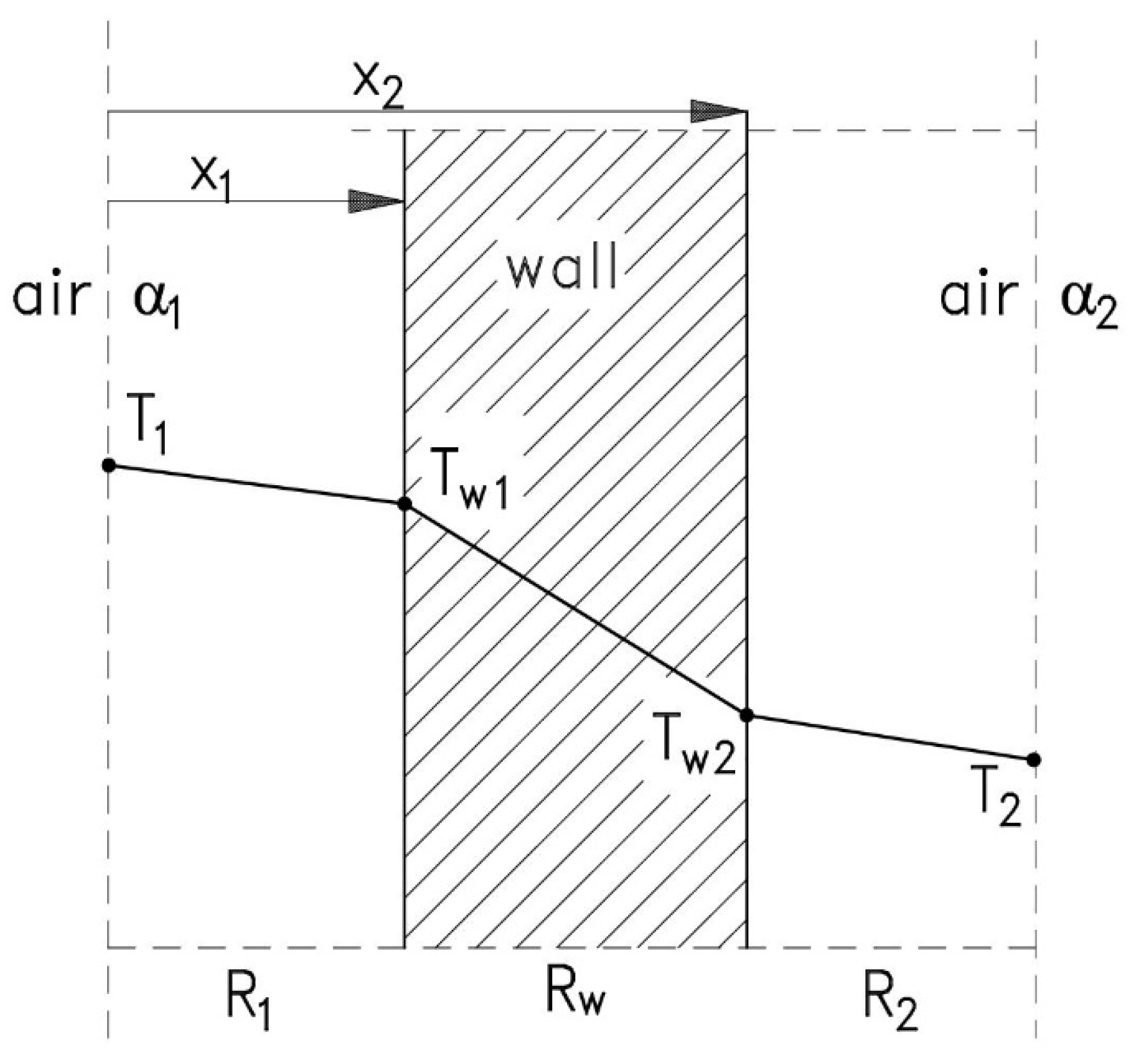
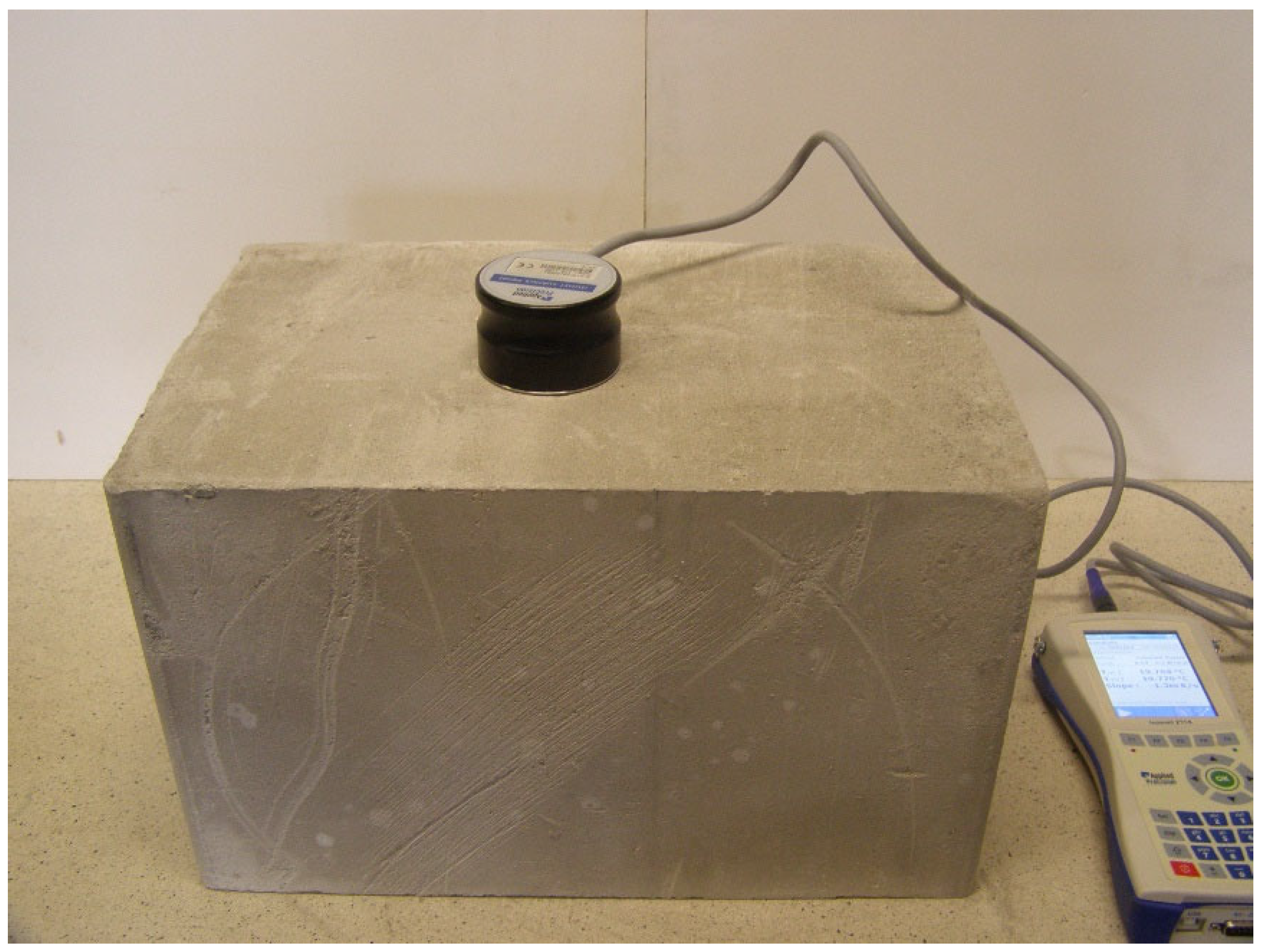
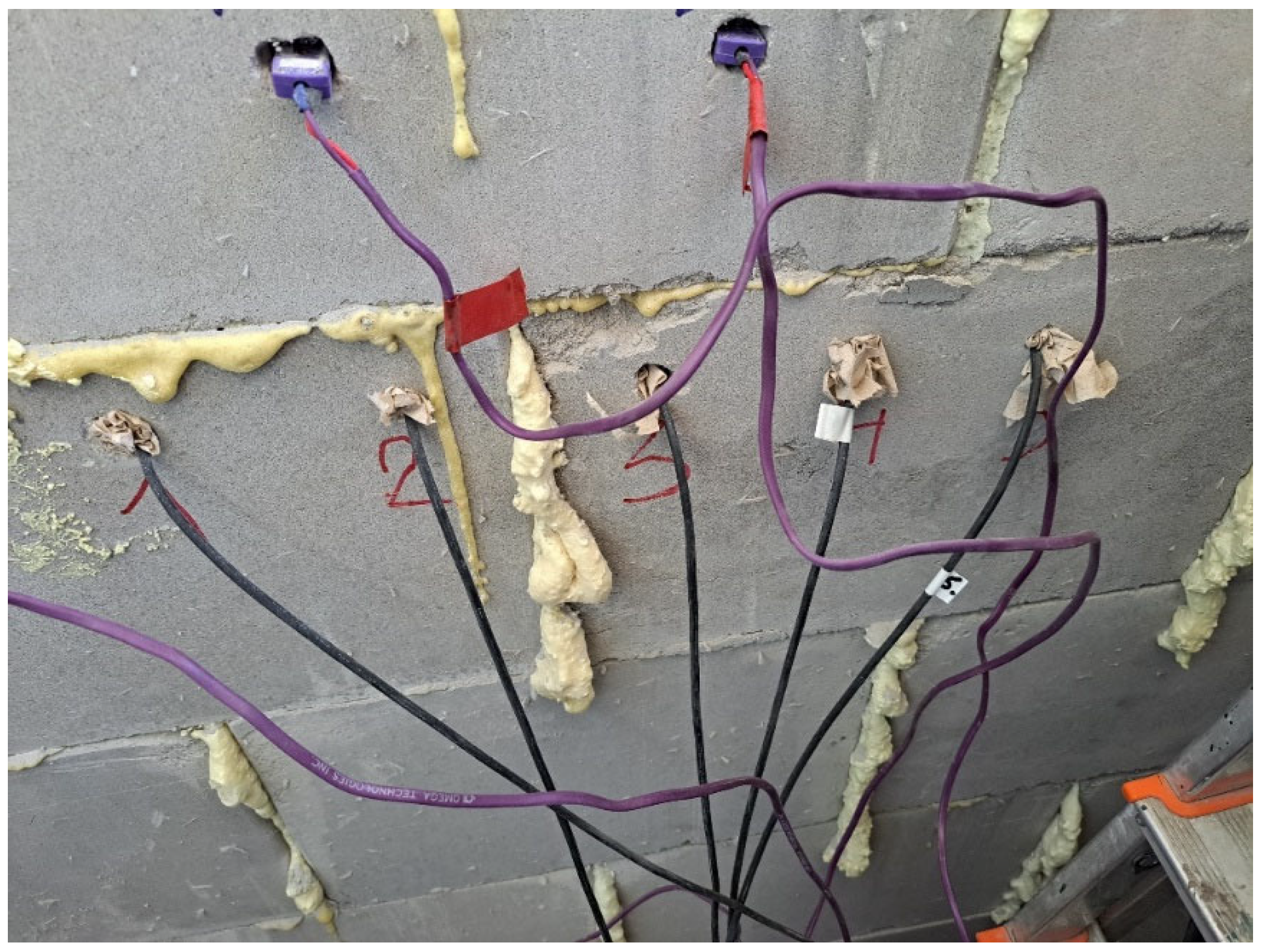
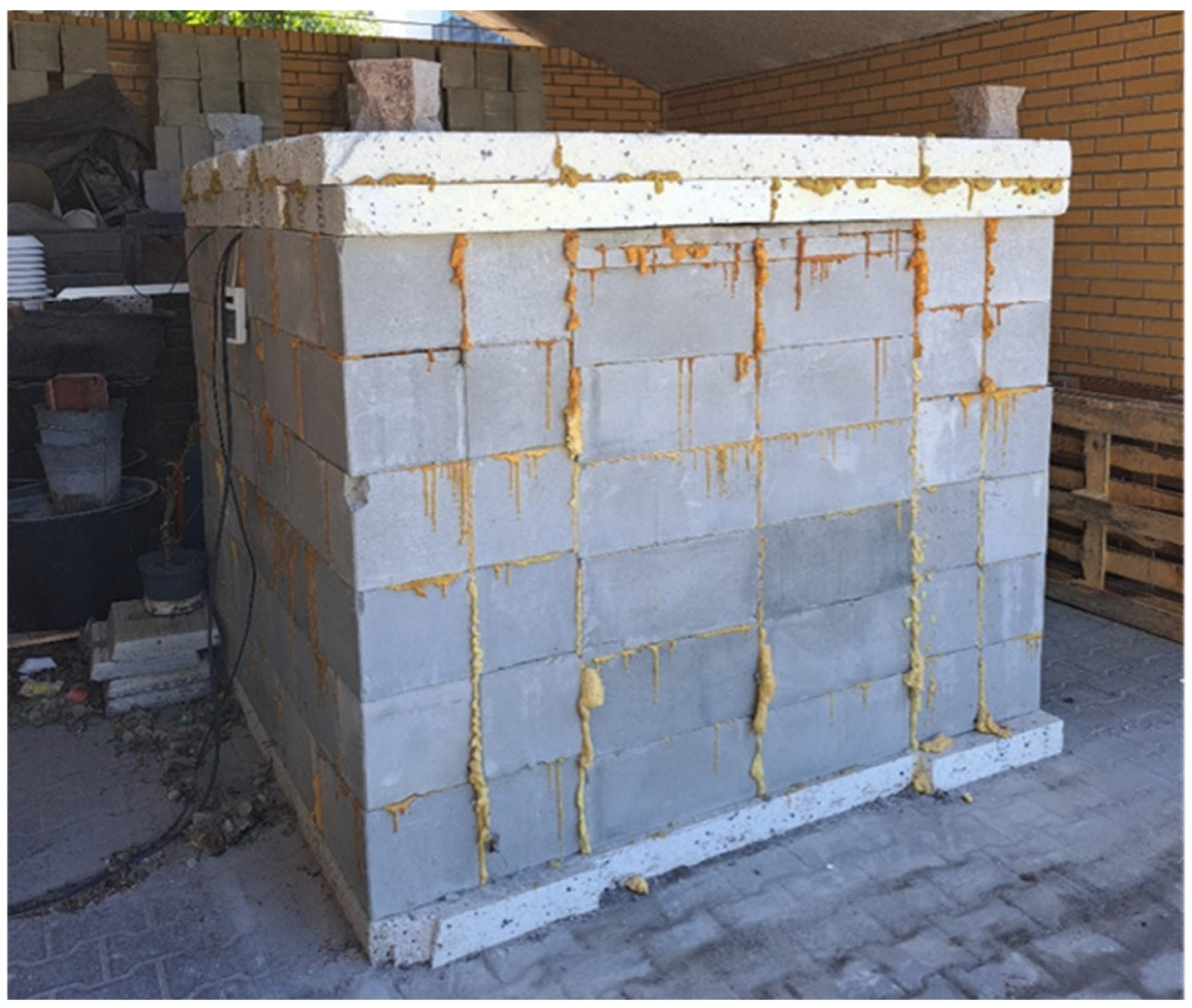
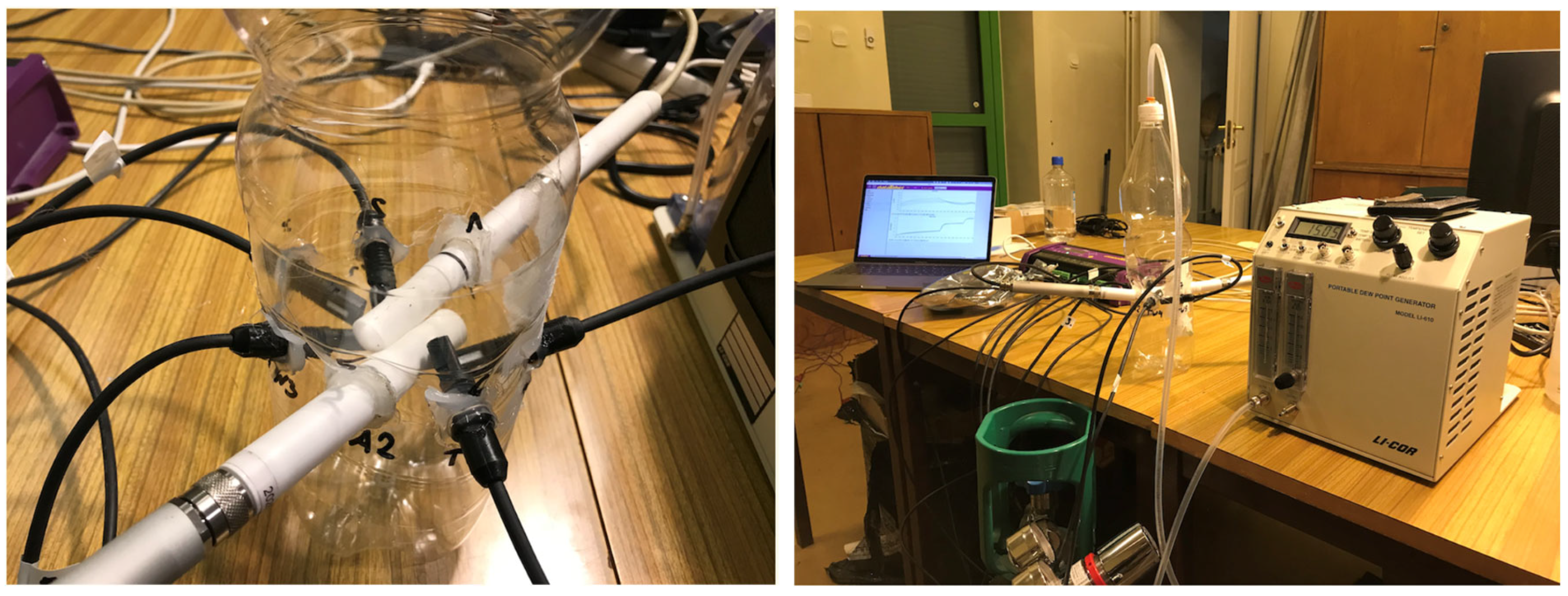
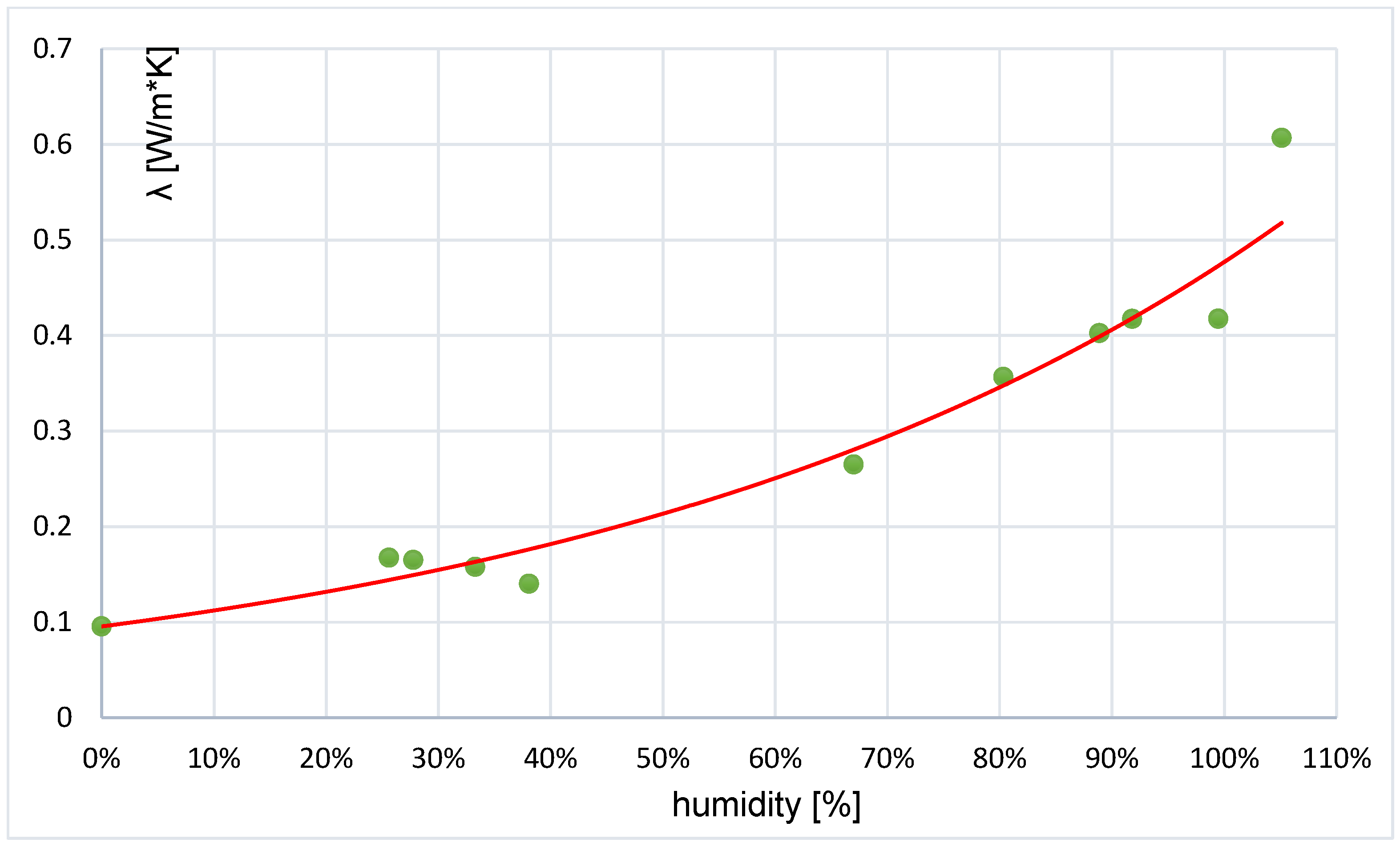
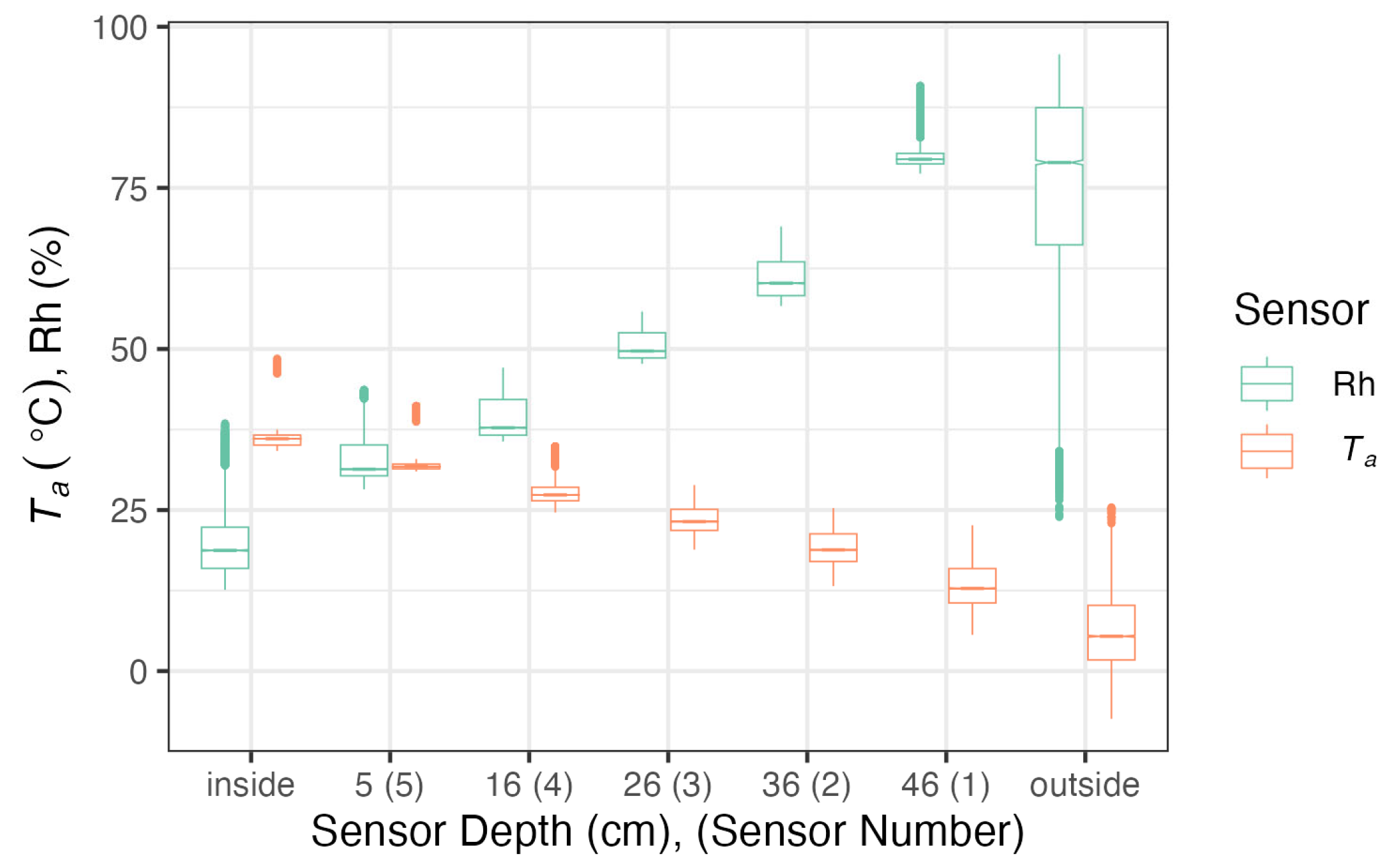
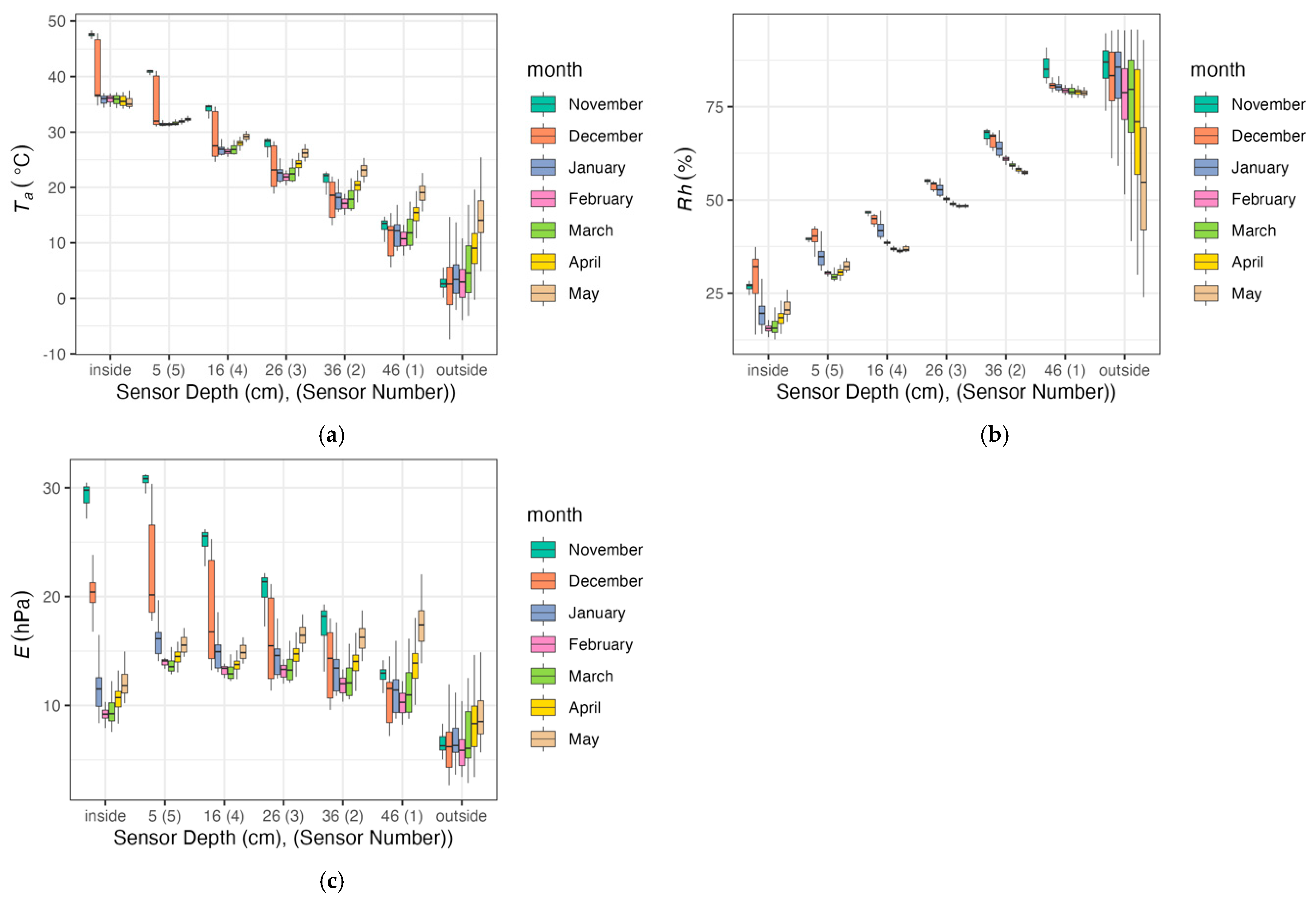
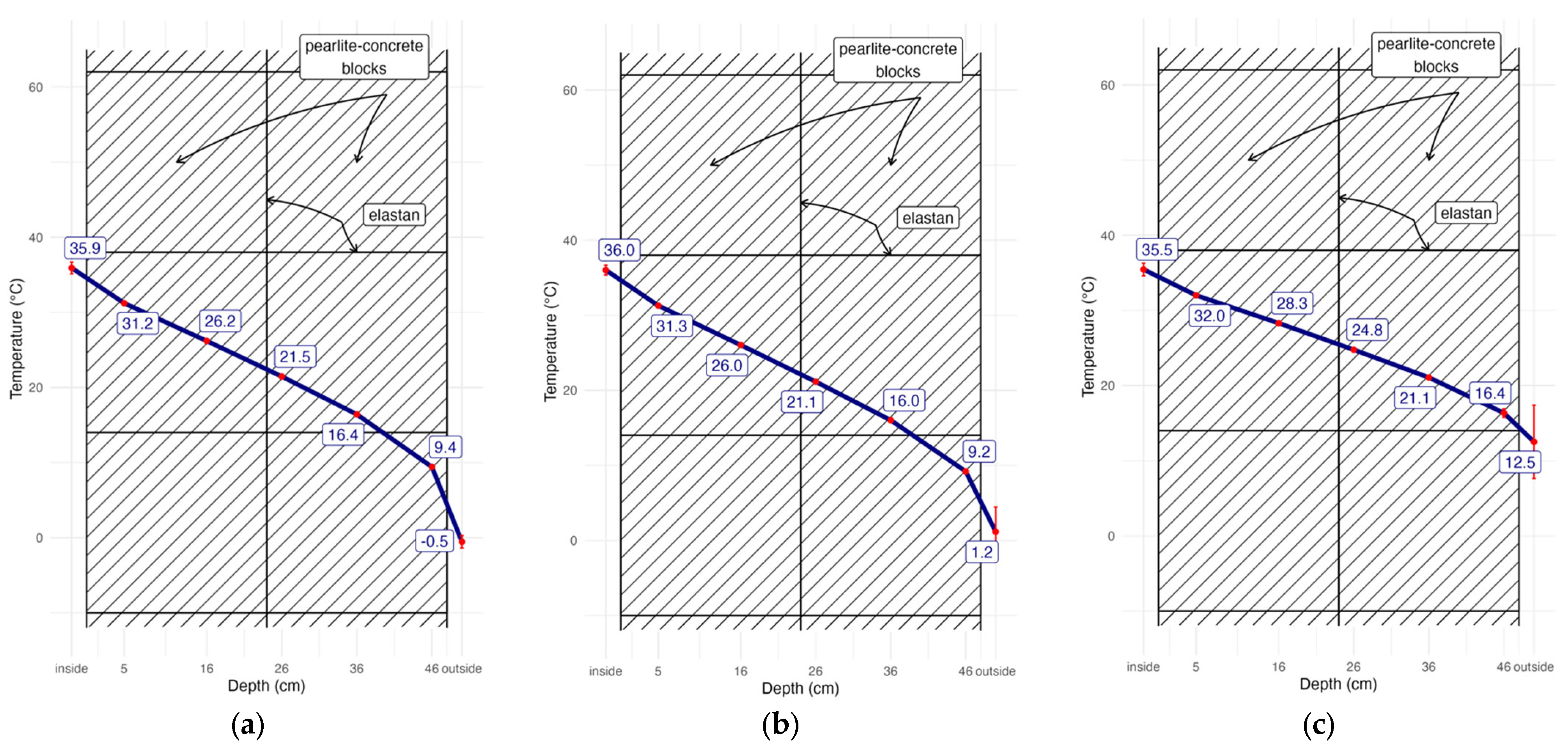
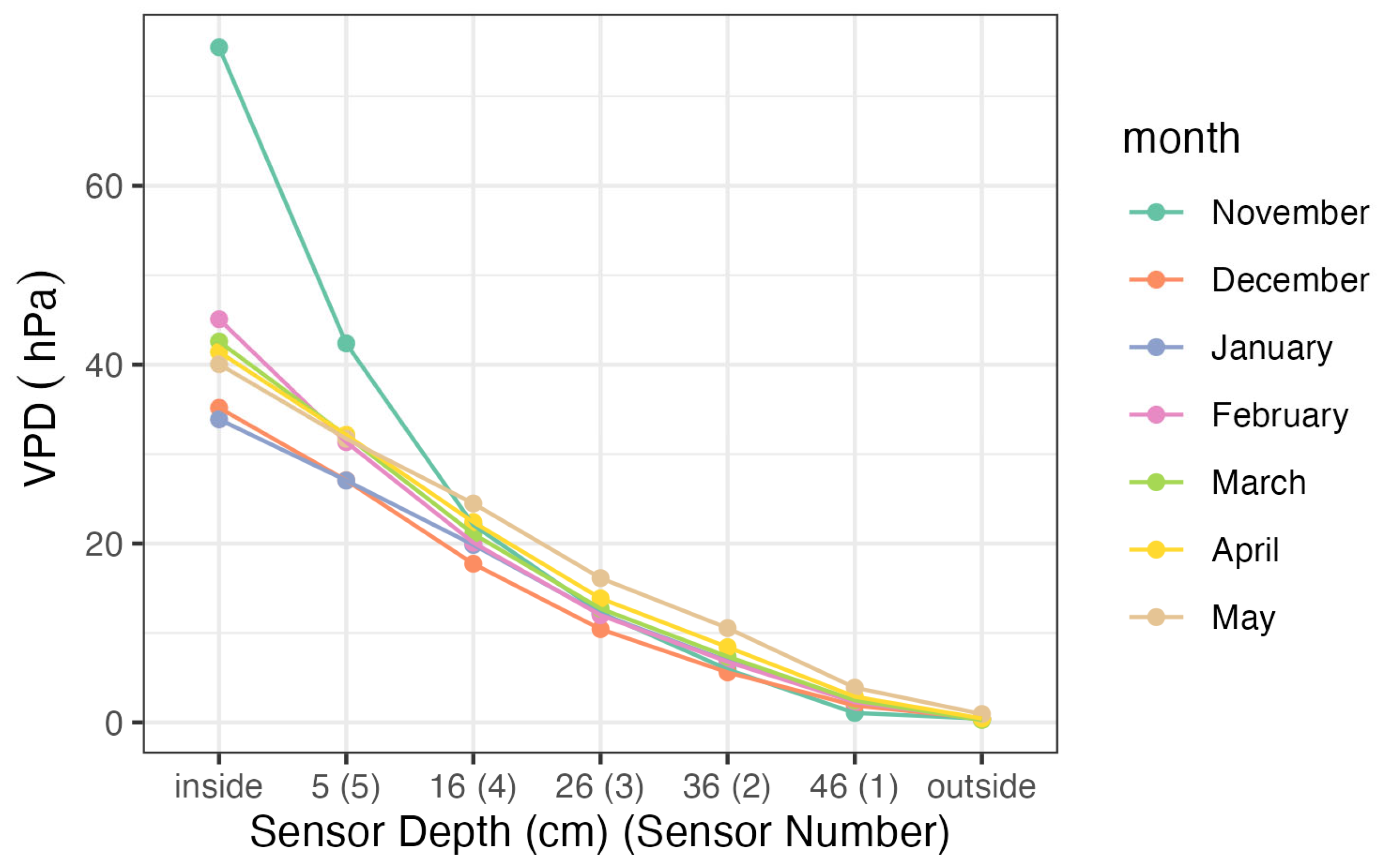
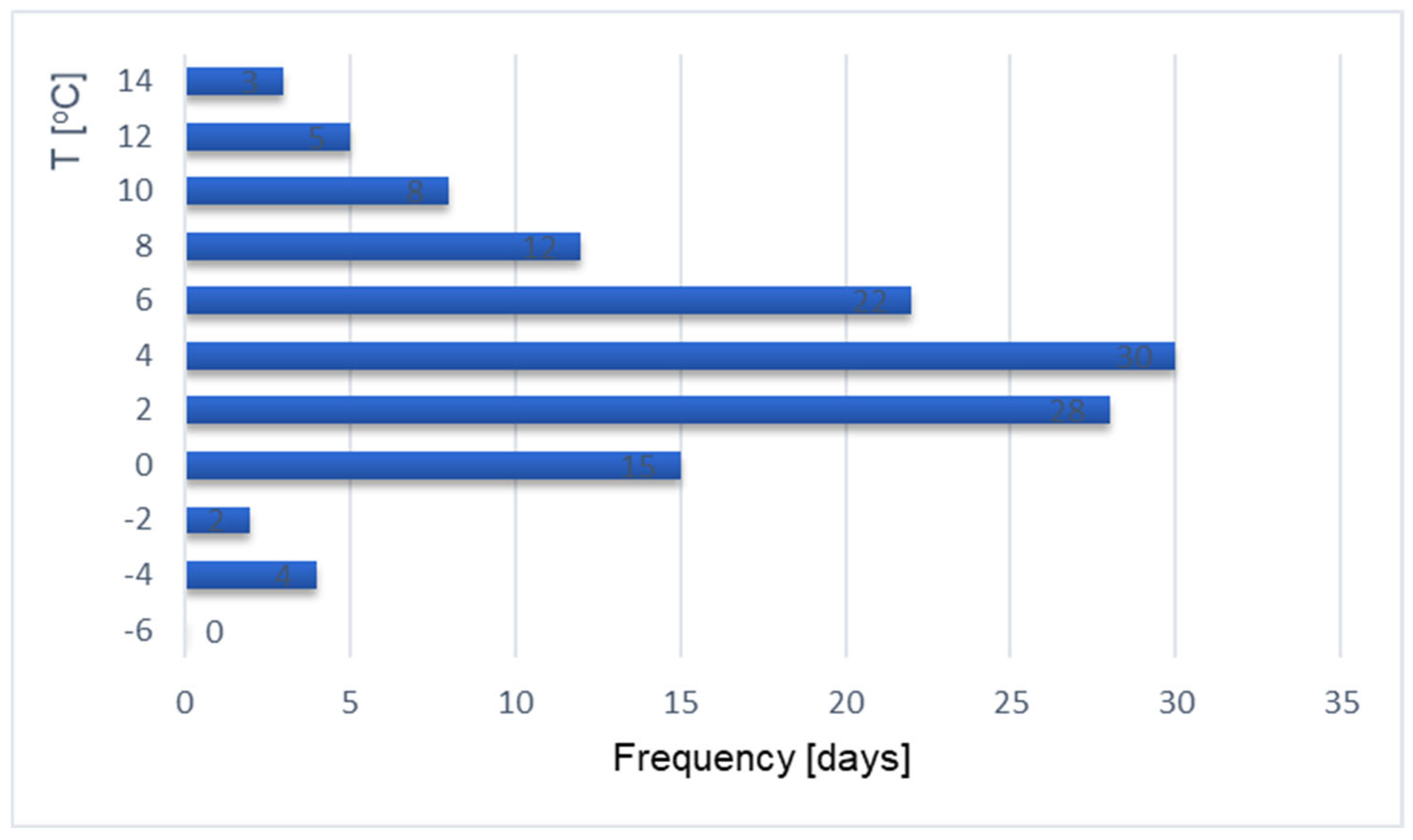
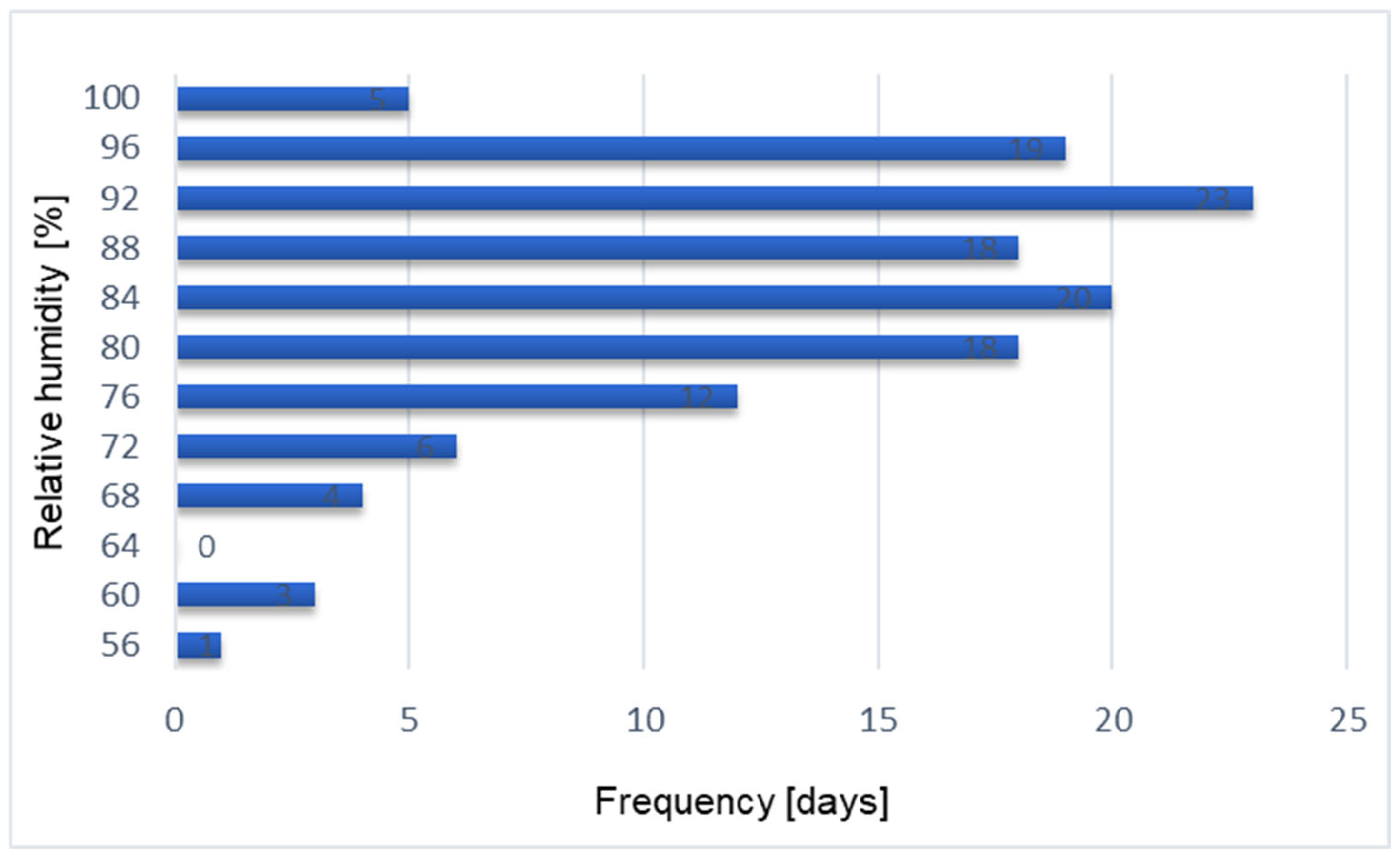



| Rh_in | Rh_out | Rh1 | Rh2 | Rh3 | Rh4 | Rh5 | |
|---|---|---|---|---|---|---|---|
| span | 1.01 | 0.92 | 0.91 | 0.96 | 0.79 | 0.97 | 0.86 |
| intercept | −0.48 | 3.68 | 2.61 | 0.54 | 10.84 | 0.59 | 7.54 |
| Correlation Coefficient |r| | Importance |
|---|---|
| 0–0.3 | poor correlation |
| 0.3–0.5 | moderate correlation |
| 0.5–0.7 | strong correlation |
| 0.7–1 | very strong correlation |
| Partition Type No. | Layers in the Partition with the Thermal Conductivity Coefficient (1) Dry Conditions (2) Humid Conditions | Thickness of Individual Layer [cm] | Total Thickness of the Partition [cm] | Heat Transfer Coefficient of the Entire Partition Dry Conditions (1) [W/m2K] | Heat Transfer Coefficient of the Entire Partition Humid Conditions (2) [W/m2K] |
|---|---|---|---|---|---|
| 1. | Perlite concrete block (discussed in this paper) λ1 = 0.0956 W/mK λ2 = 0.215 W/mK | 48 | 48 | 0.192 | 0.416 |
| 2. | Block made of porous ceramics (ρ = 800 kg/m3) with plain mortar λ1 = 0.300 W/mK λ2 = no data | 25 | 42 | 0.190 | no data |
| Thermal material λ1 = 0.040 W/mK λ2 = 0.070 W/mK | 17 | ||||
| 3. | Solid ceramic brick (ρ = 1800 kg/m3) λ1 = 0.770 W/mK λ2 = 0.910 W/mK | 25 | 44 | 0.191 | 0.317 |
| Thermal material λ1 = 0.040 W/mK λ2 = 0.070 W/mK | 19 | ||||
| 4. | ALFA cinder block (ρ = 1800 kg/m3) λ1 = 0.700 W/mK λ2 = 0.750 W/mK | 24 | 43 | 0.210 | 0.312 |
| Thermal material λ1 = 0.040 W/mK λ2 = 0.070 W/mK | 19 | ||||
| 5. | 600 aerated concrete (ρ = 600 kg/m3) with plain mortar λ1 = 0.300 W/mK λ2 = 0.350 W/mK | 25 | 41 | 0.200 | 0.315 |
| Thermal material λ1 = 0.040 W/mK λ2 = 0.070 W/mK | 16 | ||||
| 6. | Aerated concrete (ρ = 600 kg/m3) with heat-insulating mortar λ1 = 0.220 W/mK λ2 = 0.250 W/mK | 25 | 40 | 0.198 | 0.302 |
| Thermal material λ1 = 0.040 W/mK λ2 = 0.070 W/mK | 15 | ||||
| 7. | Solid silicate brick (ρ = 1900 kg/m3) λ1 = 0.900 W/mK λ2 = 1.00 W/mK | 25 | 44 | 0.192 | 0.319 |
| Thermal material λ1 = 0.040 W/mK λ2 = 0.070 W/mK | 19 | ||||
| 8. | Reinforced concrete λ1 = 1.700 W/mK λ2 = 1.800 W/mK | 25 | 44 | 0.197 | 0.331 |
| Thermal material λ1 = 0.040 W/mK λ2 = 0.070 W/mK | 19 |
Disclaimer/Publisher’s Note: The statements, opinions and data contained in all publications are solely those of the individual author(s) and contributor(s) and not of MDPI and/or the editor(s). MDPI and/or the editor(s) disclaim responsibility for any injury to people or property resulting from any ideas, methods, instructions or products referred to in the content. |
© 2024 by the authors. Licensee MDPI, Basel, Switzerland. This article is an open access article distributed under the terms and conditions of the Creative Commons Attribution (CC BY) license (https://creativecommons.org/licenses/by/4.0/).
Share and Cite
Szymczak-Graczyk, A.; Gajewska, G.; Ksit, B.; Laks, I.; Kostrzewski, W.; Urbaniak, M.; Pawlak, T. Application of Experimental Studies of Humidity and Temperature in the Time Domain to Determine the Physical Characteristics of a Perlite Concrete Partition. Materials 2024, 17, 4938. https://doi.org/10.3390/ma17194938
Szymczak-Graczyk A, Gajewska G, Ksit B, Laks I, Kostrzewski W, Urbaniak M, Pawlak T. Application of Experimental Studies of Humidity and Temperature in the Time Domain to Determine the Physical Characteristics of a Perlite Concrete Partition. Materials. 2024; 17(19):4938. https://doi.org/10.3390/ma17194938
Chicago/Turabian StyleSzymczak-Graczyk, Anna, Gabriela Gajewska, Barbara Ksit, Ireneusz Laks, Wojciech Kostrzewski, Marek Urbaniak, and Tomasz Pawlak. 2024. "Application of Experimental Studies of Humidity and Temperature in the Time Domain to Determine the Physical Characteristics of a Perlite Concrete Partition" Materials 17, no. 19: 4938. https://doi.org/10.3390/ma17194938







